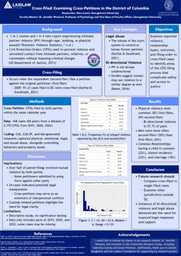Research Paper: Cross-Filed: Examining Cross-Petitions in the District of Columbia
Abstract:
Across the United States, one in three women and one in four men report experiencing intimate partner violence (IPV). To better protect those facing IPV, courts have ensured that people file for a Civil Protection Order (CPO), a court-ordered provision to protect those who file against their abusers. However, filing for a protection order becomes complicated in instances of cross-filing, when two parties file protection orders against each other. To better understand the dynamics of cross-filing, this study investigated 84 pairs of CPO cross-petitions filed in the District of Columbia. This exploratory study examined case characteristics, timing, and reported violence in cross-cases to determine if patterns of bidirectional violence or legal abuse emerged in cross-cases. Petitions were qualitatively coded using modified versions of the Composite Abuse Scale (CAS) and the Composite Abuse Scale Short Form (CAS-SF) and then input into R for frequency and descriptive analyses. Within this dataset, men were more often second-filers, and the most common relationship types reported were having a child in common (22.22%, n = 54) and sharing a residence (22.22%, n = 54). In half of the paired filings, both parties alleged physical violence against one another. Limitations, such as the fact that this study solely examines cross-petitions without regard to single-filed cases and is purely descriptive with no statistical testing, need to be addressed in future studies. However, investigating cross-petitions is important as they can provide insight into the challenges of filing for a protection order and the vulnerabilities of the legal system.

Please sign in
If you are a registered user on Laidlaw Scholars Network, please sign in